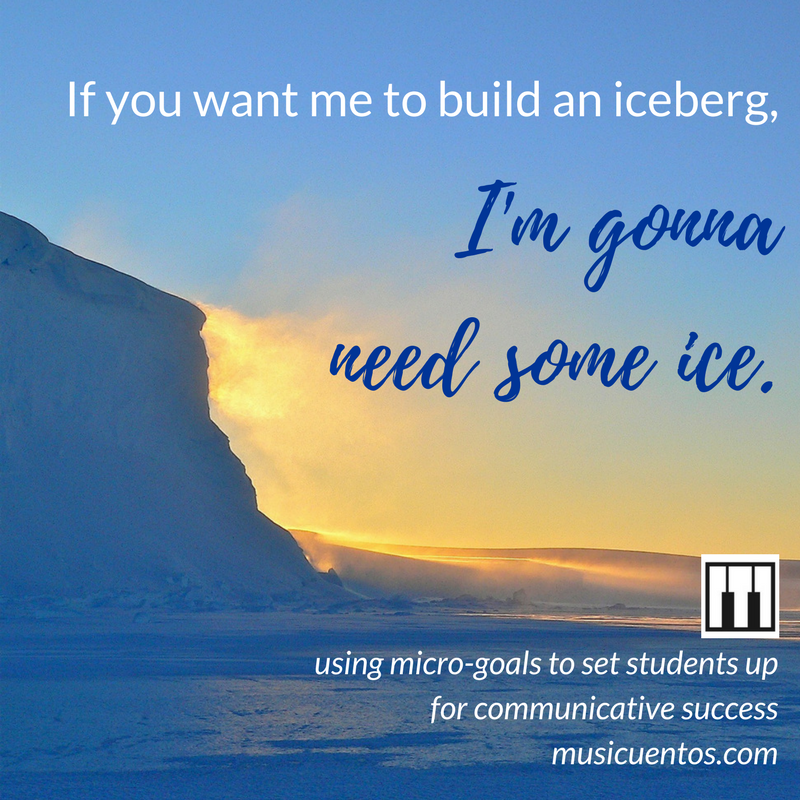We have big goals for our students.
- Tell me about yourself.
- Help us know how to get to your house.
- Describe a favorite park a Spanish-speaking tourist might visit.
- Narrate a story.
That last one is my goal for my students this year. Well, it’s not even that complicated. For my middle grades learners, who are in their third year of having Spanish once a week for 60 minutes for two 16-week semesters, our goal for the entire year is “I can begin to narrate a story.” Because that’s life, right? I want to tell you about the terrible movie I saw last week. The hysterical thing I saw at lunch the other day.
 The problem is that all of those goals, while they’re worthy, and they’re communicative, are icebergs. The nice, packaged-up story is just the tip of the iceberg. Underneath it lies so many competencies that require so much time and input to develop: vocabulary. Detail. Sequencing. Setting up a scene.
The problem is that all of those goals, while they’re worthy, and they’re communicative, are icebergs. The nice, packaged-up story is just the tip of the iceberg. Underneath it lies so many competencies that require so much time and input to develop: vocabulary. Detail. Sequencing. Setting up a scene.
How often do we provide students with input and more input and then set them in front of this iceberg and say,
Okay, so now tell me a story.
In other words, build that iceberg, and do it like you were the ice ninja. But are we giving them a realistic way to build it up, one icy skill at a time?
Here’s what I propose: let’s realize we’re asking learners to build an iceberg and give them the tool they need to do it – the input – but give them opportunities to build it over, and over, and over, laying piece, upon piece, upon piece. Eventually, the iceberg’s there, and the learner knows how to (fill in the blank).
Okay, enough of that analogy. You get my point. What do these little ice pieces look like? They look like scaffolding, like strategies where we provide students with almost everything and ask for a little, then provide them with a little less and ask for more, and so on until they’re really, really ready to tackle that goal.
Examples, please?
For my middle grades learners, we’re working through two Craig Klein Dexemple books: El ratón Pablito in the fall and Peter va a Colombia in the spring. With that said, here are a few ways I’m trying to scaffold them up to successfully narrate their own story, with links to documents you’re welcome to use.
Give them all the ice.
I made a list of phrases in four categories that are good for a story sentence:
- Scene
- Place
- Character
- Action
And then I put together a bunch of examples of each. Some are odd (“drank green, hot milk”) and some are not (“before his/her friend’s birthday”).
Every week, as a brain break, we get up and move to another part of the room, I draw a name from our popsicle-stick name cup, and that person puts together a one-sentence story using our ingredients. They don’t have to come up with any language. They just have to put it together.
So it could end up
In an elegant restaurant, during the Christmas season, a very small jaguar built a house of paper and flowers.
if the student is feeling a little goofy or creative. Or, it could end up
In a yellow and orange car, on a very cold day, a very smart girl read a book about fantastic plants.
It’s fast and simple, because it’s the same every week, but it’s different every week.
If you’d like to try this, here are my phrases in Spanish.
Here’s another one that gives them all the ice, that doesn’t require them to come up with the language. This was a sub plan that someone with minimal Spanish skills handled for me. Students were working on building up their reason-giving skills, so they put together sentences that give a reason for something using the connector porque. Here’s what that looks like.
You give some ice, they give some ice.
Another example for you: Every week after my learners and I go through one of Craig’s Pablito stories, one of their at-home assignments is to make a new story using a skeleton based on the story we already did. So they’re familiar with the language, but now they’re circling an option or providing a new word to make a new story. If you want to see how this happens, here’s our story ending with qué asco and here’s our story ending with se ríe. One of my students’ favorite parts of class is their opportunity to stand up and share their story with the class, if they want to.
In these ways, we build ice together until there’s enough of it to make up the whole iceberg. This is one of my favorite topics to discuss with teachers: how to take those big communication goals our learners have and setting them up for success by making what I call “micro-goals” that become our daily lesson plans. It’s like showing them the iceberg and then assuring them,
It’s okay. We’re going to take this one piece of ice at a time.
1 Comments
Comments are closed.




[…] was listening to the We Teach Languages podcast, and then I heard a similar idea mentioned on Musicuentos that explains how to do mini goals and […]